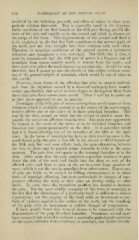Page 828 - My FlipBook
P. 828
838 PATHOLOGY OF THE DENTAL PULP.
involved in the irritation proceeds, and often of others in close sym-
pathetic relation therewith. This is especially noted in the hyperses-
thetic condition of the first branch of the fifth pair dnring jjainful dis-
eases of the eye, and equally so in the second and third in diseases of
the pulps of the teeth. This hyperesthesia of the second and third is
to be explained by the fact that both contribute to the nerve-supply of
the teeth, and are thus brought into close relations with each other.
Therefore in neuralgic conditions of the general system a peripheral
irritation may inaugurate a true neuralgia. But while this is true, it
must be remembered that the fifth pair of nerves is a frequent seat of
neuralgia from causes entirely occult or remote from the teeth ; and
these may even affect the teeth themselves prominently. It will be seen,
therefore, that I cannot go into the details of this subject without treat-
ing of the general subject of neuralgia, which would be out of place in
this article.
However, those forms of the affection that arise in antemic individ-
uals from the irritation caused by a diseased tooth-pulp have usually
certain peculiarities that serve in some degree to distinguish them from
those that arise from causes more occult. These I Avill try to point out
as they have appeared to me in practice.
Neuralgias of the fifth pair of nerves arising from occult causes or from
irritation which is probably central or in the course of the nerve-trunk,
usually affects one or the other of its three principal branches. This
may be the first, second, or third, but the second or third is more fre-
quently the seat of the affection than the first. The pain may apparently
be located in the trunk of the nerve or in its terminal branches, and
therefore may appear prominently on the skin. It is somewhat rarely
that it is found affecting two of the branches of the fifth at the same
time. In the forms of neuralgia that have as their exciting cause a dis-
eased dental pulp, the pain is first felt in the second or third branch of
the fifth pair, but very soon aflPects both, the pain alternating betAveen
the two, or there may be painful points referable to both at the same
moment. The pain does not appear in the terminal branches or in the
skin. After some time the pain manifests a peculiar tendency to pass
doAvn the side of the neck, and finally into the chest or arm of the
affected side ; and there is pain in the ear in a very large number of
cases; which is not the case in neuralgia from other causes. Paroxysms
of pain are liable to be excited by trifling circumstances, as in other
forms of neuralgic affections, l)ut more particularly by changes of tem-
perature affecting the teeth, or they come on during eating or after
meals. In some cases the recumbent position has seemed to increase
the pain. But the most reliable symptom of this form of neuralgia is
the fact that the disturbance of a particular tooth is sufficient to induce
a paroxysm ; not the rapping of the tooth with an instrument or any
form of violence applied to the surface of the tooth, but the touching
of the pulp with an instrument or sudden changes of temperature.
I have usually found this form of disease to be connected with the
degenerations of the pulp described hereafter. Sometimes several cases
have occurred that seemed to indicate a particular pathological condition
of the organ, attended with a tendency to neuralgia, but further investi-


